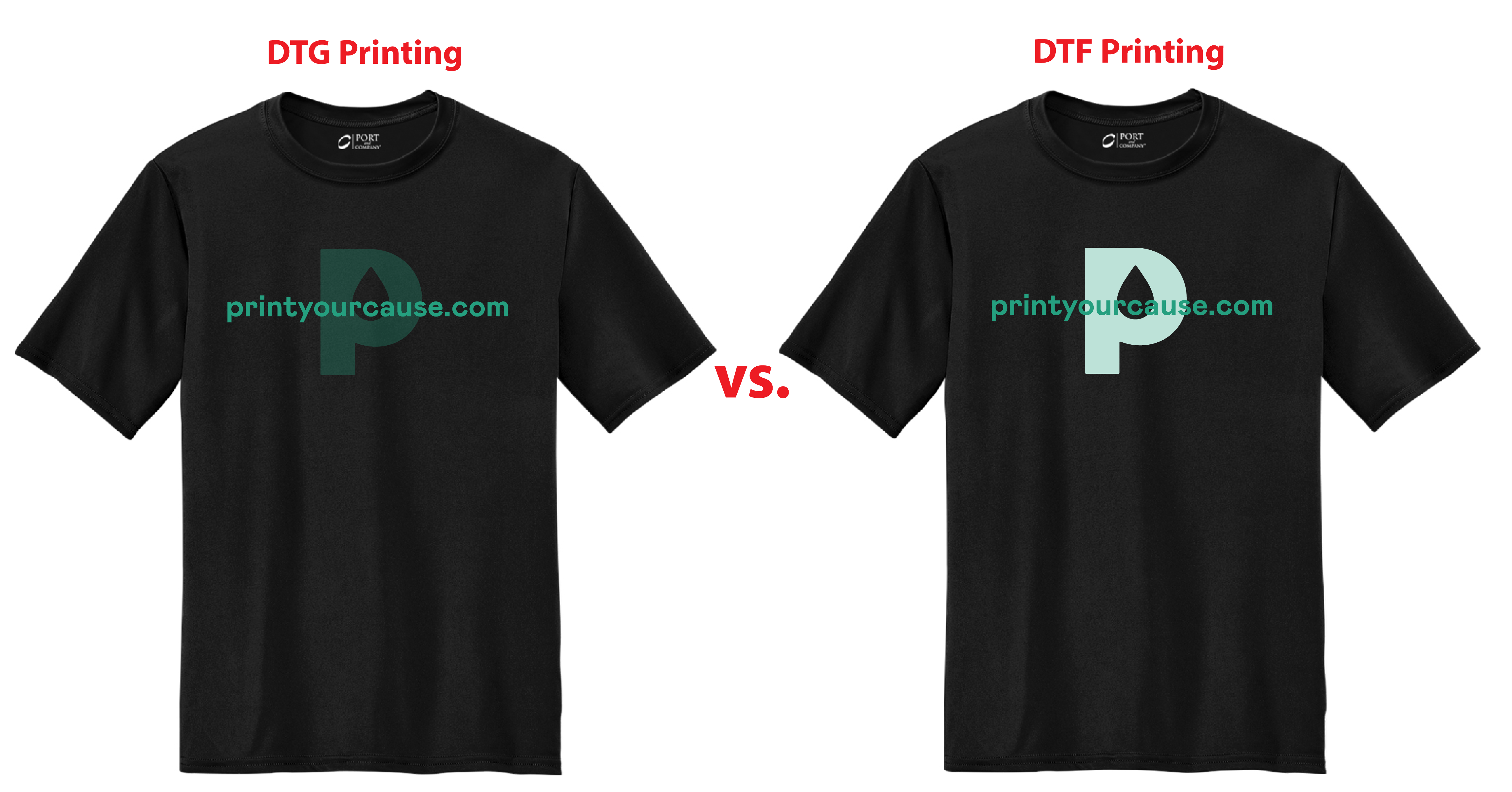For all of our decoration methods, your artwork should not be pixelated or blurry. All designs are printed as uploaded. If your artwork is pixelated or blurry, the design will be printed that way, regardless of the artwork resolution.
Direct To Garment (DTG)
Direct-To-Garment, or DTG, is a decoration method that sprays water based ink directly onto the garment. The ink then soaks into the fibers of the garment and cures with the assistance of a pretreat. It is similar to printing on paper, but on fabric!
Since the ink is water based, 100% cotton garments are recommend. However, there are some blends within our catalog which have been tested and approved.
Preparing your art for DTG: Your file should be at least 300dpi and formatted as either .png .svg .ai .eps .pdf .psd, .tif, .tiff. See Artwork Requirements, Tips & Tricks for more information.
Direct To Film (DTF)
Direct-To-Film, or DTF, is a decoration method where the ink is applied to a piece of film vs directly onto the fabric. This pre-printed film is adhered to the garment through heat and pressure from a heat-press machine.
Unlike DTG, you do not have the same fabric restrictions. This means you can utilize the DTF on-demand decoration with blended and polyester garments.
However, the only Decoration Methods that will print artwork with transparencies & opacities properly is Direct to Garment (DTG) and Sublimation. These print methods will allow the base product color to show through partially transparent graphics. DO NOT choose DTF for artwork with transparenices & opacities.
In the example below, the "P" design element is set to an Opacity of 30% for it to appear faded into the background of the shirt. The Left, DTG Printing image is how the design is meant to print. The Right, DTF Printing image is how the design will print with the improper DTF printing method. You can see the DTF print is no longer transparent because this method requires a solid white ink base layer.

Preparing your art for DTF: Your file should be at least 300dpi and formatted as either .png .svg .ai .eps .pdf .psd, .tif, .tiff. See Artwork Requirements, Tips & Tricks for more information.
Embroidery
Embroidery is a popular decoration method where a machine uses a needle and thread to stitch a design and logos to hats, polos, jackets, and more!
This method has grown in popularity within the on-demand market as a go-to method to provide an end client with a high quality decoration.
Preparing your art for Embroidery: Your file must be digitized in .dst format prior to starting your order. When selecting a file for embroidery, you should eliminate any small details or fonts which may be unable to translate when sewout.
Laser Engraving
Laser Engraving is a decoration method where the laser acts as a chisel, incising marks by removing layers from the surface of the material. The laser hits localized areas with massive levels of energy to generate the high heat required for vaporization.
Popular products to Engrave would be drinkware, cutting boards, and other accessories.
Preparing your art for Laser Engraving: Laser Engraving does restrict your art to be formatted as 1 color
Sublimation (Drinkware)
Sublimation is a decoration process where a design is inversely printed onto specific transfer paper. It is then wrapped around the end product. Once heat is applied, the image adheres to the product from the transfer paper.
Currently, we are offering the sublimation process exclusively on drinkware.
Preparing your art for sublimation: Your file should be at least 300dpi and formatted as either .png .svg .ai .eps .pdf .psd, .tif, .tiff
Cliffs Notes:
- DTG - best for cotton apparel and intricate or large designs, not great for bright/neon colored designs or apparel. You will see shirt fibers through the print.
- DTF - can be used on almost any product type. The design will be more vibrant and opaque than DTG, but may feel heavy if used with a solid-full front print. For best results, all lines in the design should be a minimum of 2 point thickness for DTF when scaled to the preferred print size - reach out to our team if you need help verifying line thickness.
- Embroidery - Requires a .dst file for each embroidery size needed in the store. Reach out to our team if you need help getting this file type.
- Engraving - Converts the design to a single color, used on colored drinkware and promo products.
- Sublimation - Used exclusively on white or stainless drinkware. Stainless will have more muted colors than the white drinkware.